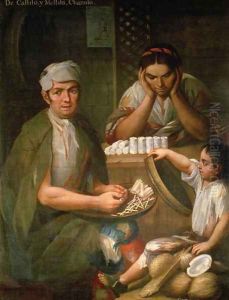Miguel Cabera Paintings
Miguel Cabrera was one of the most prominent painters in 18th-century colonial Mexico, a key figure in the Mexican Baroque period. Born in 1695 in Antequera, now known as Oaxaca, Mexico, Cabrera was of mixed Spanish and Indigenous heritage, a background that influenced his work throughout his career. Although details about his early life and training are scarce, it is believed that he moved to Mexico City at a young age, where he would eventually establish himself as a leading artist. Cabrera's work was highly sought after by both the ecclesiastical and secular elite, and he became particularly renowned for his religious paintings, portraits, and casta paintings, which depicted the racial hierarchy of the New World.
Cabrera's art is characterized by its intricate detail, vibrant colors, and the incorporation of religious and indigenous symbols. He was deeply influenced by the Spanish Baroque style, yet his work also reflects a uniquely Mexican aesthetic. One of his most famous works is the 'Virgin of Guadalupe' (1755), which is housed in the Basilica of Guadalupe in Mexico City. This painting was significant not only for its artistic merit but also for its role in promoting the Virgin of Guadalupe as a national symbol of Mexico.
In addition to his religious works, Cabrera's casta paintings are of particular historical interest. These paintings were part of a genre that sought to document and classify the complex system of racial categorization in colonial Mexico. Through these works, Cabrera provided a detailed and nuanced portrayal of the diverse society of New Spain, offering valuable insights into the social dynamics of the time.
Cabrera was not only a prolific artist but also an influential figure in the art community of New Spain. He founded the Academy of Saint Joseph in Mexico City, a significant institution in the development of Mexican art, where he trained and mentored the next generation of Mexican artists. His contributions to the Mexican art scene were immense, and his legacy is evident in the continued appreciation and study of his work.
Miguel Cabrera died in 1768 in Mexico City, leaving behind a vast oeuvre that continues to be celebrated for its artistic excellence and historical significance. His paintings are preserved in various museums and churches across Mexico and are considered national treasures, emblematic of the rich cultural heritage of the country. Cabrera's life and work offer a fascinating window into the colonial history of Mexico and the intersection of European and Indigenous artistic traditions.
